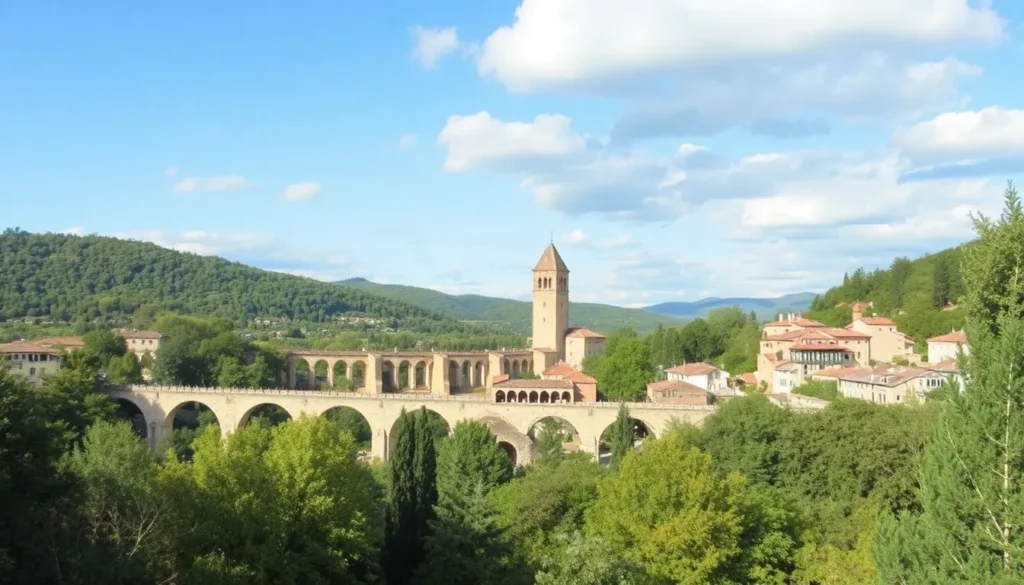6 things to see and do in Besalú

Besalú consistently ranks among the top spots on lists of the most beautiful villages in Catalonia, a well-deserved honor for this enchanting medieval gem. If you're planning a visit, you're in for a treat! In this article, we'll delve into the top 6 things to see and do in Besalú, ensuring you experience the essence of this captivating locale. Whether you’re searching for unique attractions or local experiences, there are plenty of things to do in Besalú, Spain.
Located in the picturesque region of La Garrotxa, this village is renowned for its perfectly preserved medieval historic center. During the Middle Ages, Besalú served as a significant commercial and political hub, largely due to its strategic position along the Fluvià River. The river offers stunning views of its most prized possession: the magnificent Romanesque Bridge. But let's not spoil the surprises—let’s explore all that Besalú, Spain has to offer!
Discovering the Romanesque Bridge of Besalú
The Romanesque Bridge of Besalú is the most iconic monument of the town, welcoming visitors right from the start. With convenient free parking nearby and the tourist office just steps away, it sets the tone for your visit.
Originally constructed in the 11th century over the Fluvià River (though it has undergone several reconstructions), this architectural marvel boasts seven arches of varying sizes. It also features two fortified towers, one of which is hexagonal, illustrating its defensive purpose for controlling access to the town's walls (where travelers were once required to pay a toll). Luckily for us today, crossing is completely free!
Wandering Through the Historic Center
As you cross the bridge, you'll be immersed in the charming network of cobblestone streets that make up Besalú's historic center. We recommend following the main street and taking in all the small details: the stone facades of the grand houses evoke the medieval era, showcasing sculptural decorations that reflect the wealth of the time. Even the souvenir shops and artisanal workshops have their own unique charm, making it difficult to resist picking up a memento.
Next, make your way to the flour mill and the riverwalk: along the riverbank, you can capture stunning photos of the Roman Bridge. Afterwards, take a stroll along the ancient walls of Besalú, where you'll find viewpoints and sculptures, adding to the list of delightful things to do in Besalú, Spain.
Exploring the Sinagogue and Mikvé
A fascinating part of Besalú's history is the ancient Sinagogue and Mikvé, which serve as poignant reminders of the once-thriving Jewish community that lived here during the Middle Ages, prior to their expulsion by the Catholic Monarchs in 1492. Even after five centuries, the cultural heritage of this community, which inhabited the "call" (or Jewish quarter), remains significant. Efforts to highlight this history include events like the "Besalú Jewish City" days held in early March.
- Sinagogue: Built in the 12th century, this is one of the best-preserved medieval synagogues in Spain and a remarkable example of Jewish religious architecture of the time. It features Romanesque elements and unique details that reflect the cultural and religious life of the Jewish community in Besalú.
- Mikvé: This is one of the few medieval mikvaot still in existence across Europe. It is a Jewish ritual bath used for purification before sacred days or important events. Dating back to the 12th century, it is located near the synagogue. From its entrance, you can also enjoy a beautiful view of the river and the Roman bridge.
Important: To visit these sites (which is highly recommended), you'll need to book a guided tour through the tourist office or via a reputable provider like Civitatis.
Monastery of Sant Pere de Besalú
This ancient Benedictine monastery was founded in the 10th century and expanded in the 12th century, serving as one of the primary religious and cultural centers of the area during the Middle Ages. The church, remodeled in 1160, showcases a basilica structure with three naves and a large central apse surrounded by an ambulatory.
At the main entrance, you can see the statues of two lions, often symbolically used as guardians or protectors during that era. The predominant style is late Romanesque, with some Gothic elements incorporated.
Tasting Local Delicacies
In the same square as the monastery (Plaça Prat de Sant Pere), you’ll find a few bars and restaurants with terraces where you can relax and recharge while enjoying local dishes, such as patatas de Olot or butifarra with Santa Pau beans.
We opted for the daily menu at Restaurant Amadeus, and despite mixed reviews on Google, we enjoyed our meal: for €15, you get a starter, main course, water or wine, and dessert. Another place that caught our eye is NOX Arrosseria, perfect if you're in the mood for a delicious rice dish!
Visiting Circusland
Did you know that Besalú is home to a curious museum? Welcome to Circusland, where you can delve into the 250 years of circus history and heritage. This small museum, designed with a pedagogical focus, is ideal for families looking for activities in Besalú, Spain. It features the world’s largest model of a miniature circus, interactive spaces, circus philately, costumes, photographs, and merchandise.
While Besalú can be explored in a couple of hours, if you wish to spend one or two nights here, consider these recommended accommodations: Hotel 3 Arcs, Els Jardins De La Martana, or Mas Pere Pau, which is slightly away but has a lovely pool!
More Things to Do in Besalú
If you have more time, fantastic! Here are a few additional sites in Besalú (and its surroundings) that are definitely worth your visit:
- Church of San Vicente: Built in the 12th century in Romanesque style, it is known for its sober and elegant architecture, featuring a single nave and a semicircular apse. The tomb of Pere de Rovira, who moved the relics of Sant Vicenç to Besalú in 1413, is located here.
- Old Hospital of Sant Julià: Founded in the 12th century to care for pilgrims, it has preserved its main façade in Romanesque style.
- The Interpretation Center Espai Besalú (entry fee €3) is a small exhibition housed in what once was the home of a notable family, known as Curia Real, detailing the village's history from its inception to the present.
- Lastly, make sure to visit Castellfollit de la Roca, a unique village perched atop a basalt cliff formed by the confluence of the Fluvià and Toronell rivers.
If you haven't had the chance to explore this beautiful town, recognized as one of the best-preserved medieval ensembles in Catalonia, don't hesitate to plan a getaway to Besalú, Spain! We hope you enjoyed this guide and that you now know everything you need about what to see and do in Besalú, Catalonia. Have you been? What did you think?
Avoid overspending on your journey:
| Save on your trip |
| Compare and find cheap flights here |
| Find accommodations at the best prices here |
| Book the best activities and excursions here |
| Get a 5% discount on your travel insurance from IATI here |
| Reserve airport transfers here |
| Gift of €10 when booking transport across Europe here |
| Learn how to withdraw money without fees here |
| 5% discount on your eSIM from Holafly here |
| Rent a car with the best deals here |
| Compare prices for van rentals here |
| The best books and travel guides here |
| All our articles about Spain |




Deja una respuesta